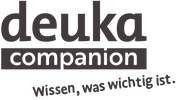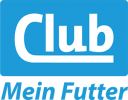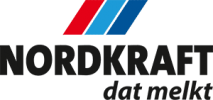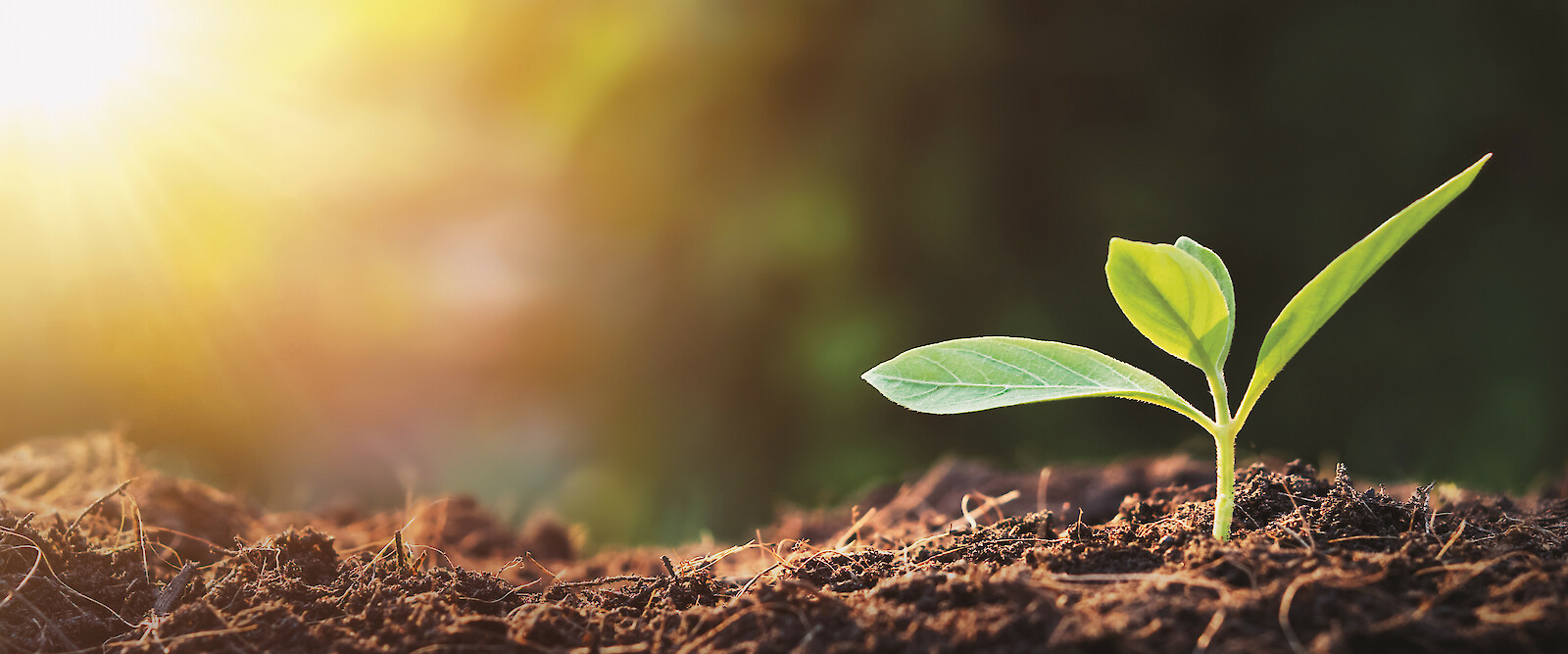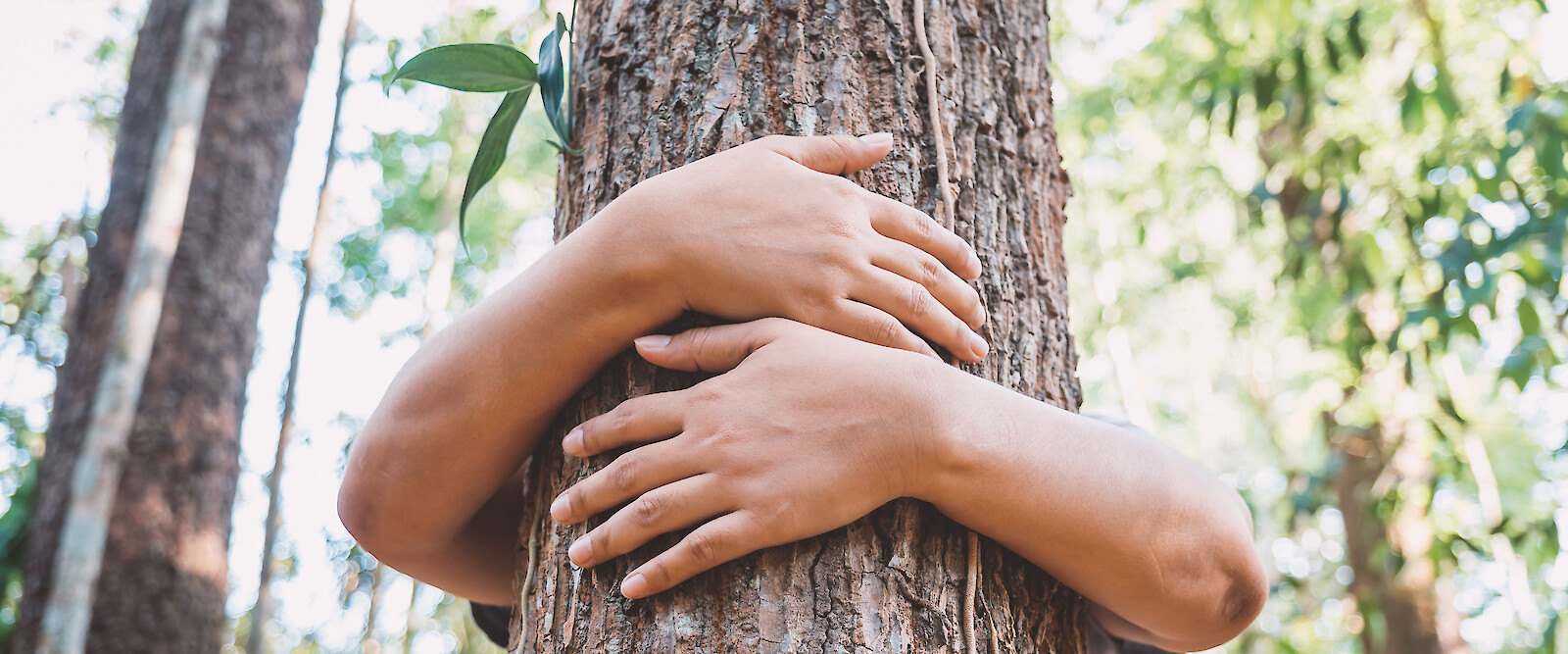Sustainability
As a compound feed manufacturer, we process natural raw materials into nutritious feeds for animal consumption. From the procurement of raw materials, to their processing, to the delivery of finished feeds to the farms, our products go through numerous processing steps. As a sustainable animal feed producer, we take responsibility for the manufacture of our products. We strive to make the entire production process as efficient, environmentally and climate-friendly as possible. This is the only way we can conserve resources and make an active contribution to shaping a more sustainable world.

What we do for the production of sustainable feeds
-
Mixed feeds consist of precisely coordinated components. The choice of ingredients is based on the needs of the animals. Different products are used to ensure their supply. The majority of the raw materials (approx. 80 %) that we use in our feeds come from agricultural traders and farmers in Germany and other European countries.
Soy - working together for reduced and more sustainable use
An important source of protein in some feeds is soy and the meal made from it. Cultivation in Germany alone cannot cover the demand. We therefore source our soya mainly from European and traditional cultivation areas in North and South America. We are the first German compound feed company to have committed to switching our production to the exclusive use of sustainably certified soy meal by 2025 - we are continuously increasing the proportion of sustainably certified soy meal in our production. When using Brazilian soy meal, we already use only products from suppliers who have signed the soy moratorium. This ensures that we only use products that do not come from areas in the regions concerned that were cleared after July 2008. In addition, we have reduced the use of soy by about 40% in recent years and use alternative feeds such as sunflower and rapeseed meal as well as gluten feed and slurry. In this way, we are doing our part to reduce the development of additional cultivation areas at the expense of nature and to relieve the strain on the soils in the cultivation regions.
Sustainable palm oil
For healthy animals and good food, the quality of the fats used in the feed is of considerable importance. Depending on the animal species, different fats with different fatty acid patterns and compositions are used in the feeds we produce. Typical components are fatty acids from rapeseed, sun, maize, palm and partly also palm oil. We have concluded contracts with our suppliers to the effect that the mixed fats produced for us may only contain palm oil from sustainably certified cultivation. In this way, we contribute to the expansion of the production of sustainable palm oil.
-
Regional sourcing favoured
Over 80 per cent of the raw materials we use come from the European continent. A large part of this is grain from regional cultivation, which we receive from agricultural traders and farmers from all over Germany. Proximity to our customers has always been of central importance to our company. Thanks to the even distribution of our 14 plants throughout Germany - from Emden to Memmingen and from Neuss to Herzberg - we keep our transport and delivery routes short. This saves time and reduces unnecessary emissions.
Using more climate-friendly means of transport
Many of our plants are connected to shipping and/or the rail network. This allows us to procure raw materials that are not available regionally and therefore have to be procured supraregionally using more climate-friendly means of transport. Where delivery by truck is unavoidable, we strive for maximum utilisation of all vehicles. In doing so, we pay meticulous attention to avoiding empty runs. All this helps us to reduce theCO2 impact of our food.
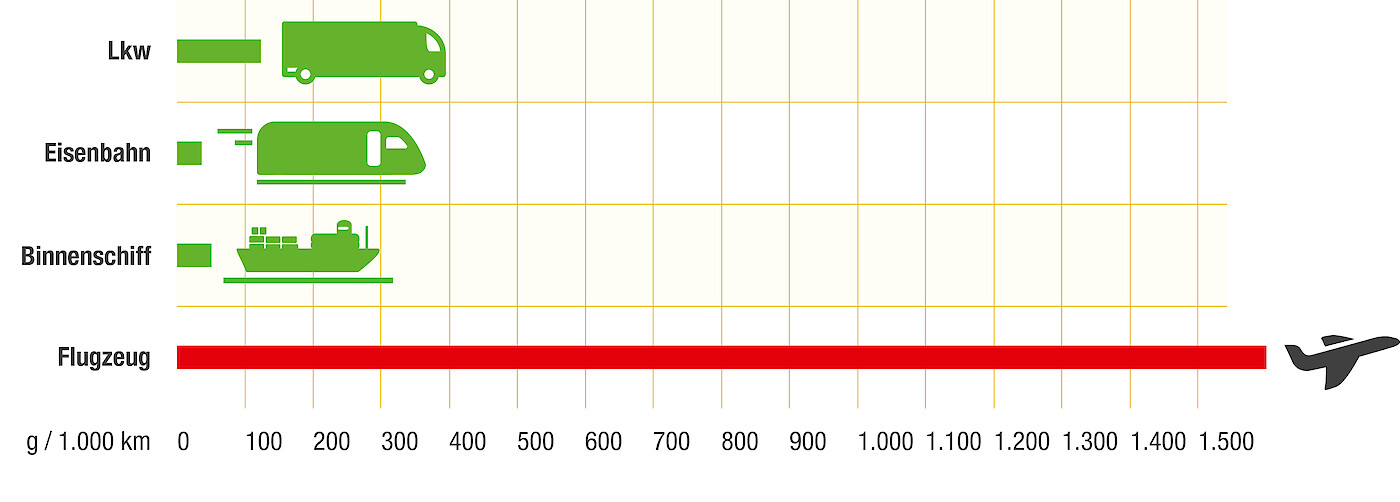
A comparison of the average emissions of individual means of transport in freight traffic by the Federal Ministry for the Environment (BMUV) showed in 2010 that aircraft produce by far the highest CO2 emissions per kilometre travelled and in relation to freight. We mainly use trucks, goods trains or cargo and container ships to transport our raw materials (© Deutsche Tiernahrung Cremer). -
Improving energy efficiency and reducing air emissions
As a company with modern, highly automated production, energy efficiency is an important issue for us. In order to reduce energy consumption and thus reduce emissions, we work with an effective energy management system. The ISO 50001 standard, to which we have been certified since 2012, obliges us not only to record our energy sources and consumption, but also to constantly improve the energy efficiency of our production. In the course of achieving the energy targets we have set ourselves, we have also implemented the following measures:
- Project or maintenance-related replacement of electric motors in our factories with modern models with the highest available efficiency standard at the time of replacement to reduce energy and emissions.
- Installation of energy-efficient steam boiler systems and compressors with heat recovery systems at all sites.
- Compliance with all applicable energy saving regulations as part of any necessary changes to our plants.
Compliance with all requirements of the Federal Immission Control Act
By using different technologies in all our plants, we comply with all the guideline values specified by the Federal Immission Control Act (BImSchG) in order to protect people and the environment from harmful influences. The law and its regulations set clear requirements for the pollution caused by various emissions (noise, dust, odours). Among other things, we are also improving the air quality in our production facilities and making it easier for our employees to work in the factories.
MoVe innovation system
The maintenance of our innovation system MoVe ("Employee-Oriented Improvement Process") also contributes to the continuous improvement of our internal processes. MoVe is a system for continuous process optimisation in administration and production. All employees can contribute to MoVe and submit suggestions. The system has led to the following improvements, among others:
- Elimination of plastic inliners in a number of paper bags.
- Reduction of compressed air consumption in all plants.
- Reduction of steam consumption (Heilbronn).
Avoidance of waste and plastic
More than 95 per cent of our customers receive our goods in bulk. This fodder is loaded directly into lorries and delivered to the farms. There is no packaging waste. However, since our pet customers often have fewer animals, we also offer our products for poultry, horses, rabbits and the like in sacks. To make the packaging as environmentally friendly as possible, we almost exclusively use paper bags.
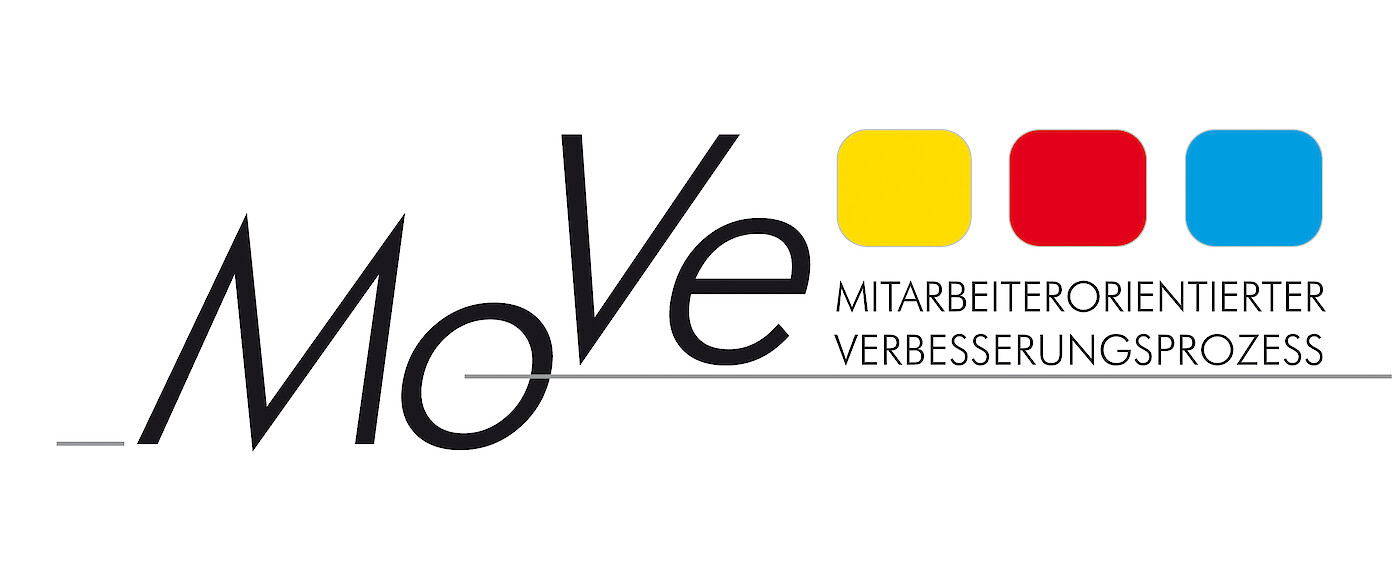
Logo MoVe -
Optimised feed to avoid slurry and emissions
Our customers in agriculture in particular usually keep large numbers of animals. The herds lay tasty eggs and give healthy milk, but they also produce manure and a certain amount of emissions. By constantly optimising the recipes of our feeds, we improve the feed utilisation in the animals' gastrointestinal tract. The better cattle, pigs and poultry can absorb the components of the feed, the less waste products are produced.
As an innovative compound feed producer, we are working feverishly to develop nitrogen- and phosphorus-reduced feeding concepts. These modern, highly effective feed concepts provide the animals with the performance and requirements they need, but reduce the pollution of soils and water by slurry (see illustration). At the same time, we are researching - in the spirit of sustainable feed development - howCO2 emissions can be reduced with the help of appropriately designed feeding concepts. To this end, we work closely with renowned institutes of agricultural science and animal nutrition (e.g. Osnabrück University of Applied Sciences), global companies (e.g. BASF) and industry associations (e.g. DVT).
Optimising feed utilisation for less waste products in agriculture
In order to further increase the utilisation of forage, we use state-of-the-art production processes in the manufacturing process. Our patented opticon® process plays a key role in this. The pressure hydrothermal digestion of the feed components maximises the absorption and digestibility of our products in the animals' gastrointestinal tract. The high degree of material conversion achieved by the process technology is purely physical, without the use of additives. Feed treated with the opticon® process is better utilised by the animal. This protects the environment through less protein in the daily ration.
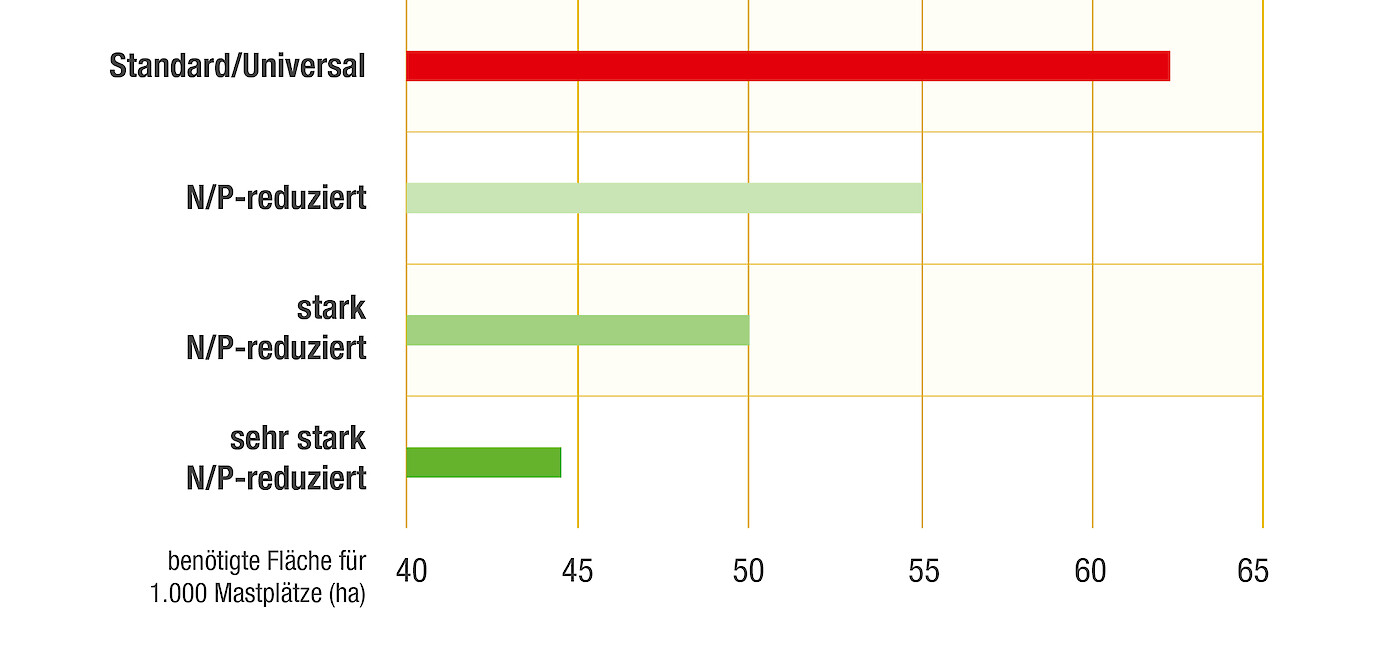
Nitrogen- and nitrate-reduced (N/P) feeding helps to minimise unnecessary discharges into the environment. The example shows that switching from a standard to a very N/P-reduced diet in a pig farm with 1000 places reduces the area needed to spread the pigs' manure by about 30 percent (© Deutsche Tiernahrung Cremer). -
Our relentless pursuit of sustainable, environmentally sound and climate-friendly business practices is framed within a framework of self-imposed standards of conduct. In our Code of Conduct, sustainability is prescribed as the central guiding principle for our operational actions.
Interdisciplinary team ensures even more sustainability
An interdisciplinary team of employees from different departments serves as a driving force in the development of new sustainability goals and solutions. But we do not act alone in our efforts to achieve sustainable production: through participation in various committees (e.g. DVT, FEFAC, DLG, UFOP) we discuss sustainability issues and targets with our cross-industry partners around the world. We are convinced that we can only find sustainable solutions together.
Living a culture of diversity
Sustainability without a social component lacks depth and authenticity. A living culture of diversity is therefore an essential aspect of our responsibility. More than 700 employees from 14 nations work in our plants and offices (as of 2020). In particular, the training of new skilled workers in almost half a dozen professions has traditionally been close to our hearts. At just under 10 per cent, we have an above-average trainee ratio. Our varied training programme combines theory and practice. The goal is always to take on young, motivated people into our "yellow" family.
News on the topic of sustainability
Image credits (top slider): © patpitchaya - stock.adobe.com / © lovelyday12 - stock.adobe.com
